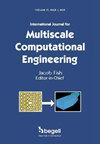颗粒材料中粒径对二维拱效应发展和降解的微观机制
IF 1.4
4区 工程技术
Q2 ENGINEERING, MULTIDISCIPLINARY
International Journal for Multiscale Computational Engineering
Pub Date : 2023-01-01
DOI:10.1615/intjmultcompeng.2023049782
引用次数: 0
摘要
本文通过一系列的DEM数值模拟,研究了不同平均粒径的经典二维活板门问题中拱效应发展和退化的微观机制。研究了颗粒在拱效应作用下的宏观和微观行为。模拟结果将位移控制活板门上方的颗粒组合划分为三个区域:屏蔽区;分拱区和稳定区,根据颗粒的垂直位移程度进行分析。仔细评估了相对于活板门宽度的平均粒径对各个区域的影响。微观参数,包括摩擦动员指数、平均配位数和平均颗粒接触力,都受到平均粒径的影响,并在三个区域表现出不同的行为。在不同粒径的颗粒样品中,拱区内的平均颗粒接触力与拱效应演化的相关性最高。这些发现不仅为颗粒尺度机制与宏观成拱效应之间的关系提供了新的见解,而且突出了平均粒径对颗粒材料中成拱效应演化的影响。本文章由计算机程序翻译,如有差异,请以英文原文为准。
Microscopic mechanisms of particle size effect on 2D arching effect development and degradation in granular materials
This study carries out a series of DEM numerical simulations to investigates the microscopic mechanisms of arching effect development and degradation in classical 2D trapdoor problem with different mean particle sizes. Both the macroscopic and microscopic behaviours of particles under the influence of arching effect are examined. The simulation results of the granular assembly above a displacement-controlled trapdoor are divided into three zones: a shield zone; an arch zone and a stable zone, according to the extent of particle vertical displacement for analysis. The impacts of the mean particle size relative to trapdoor width on various zones are carefully evaluated. Microscopic parameters, including the friction mobilisation index, the average coordination number, and the mean particle contact force, are found to be all influenced by the mean particle size and show different behaviours in the three zones. The average particle contact force within the arch zone shows the highest correlation to the evolution of arching effect in particle samples with different particle size. These findings not only provided new insights into the correlation between the particle scale mechanisms and the macroscopic arching effect but also highlight the mean particle size influence on the evolution of arching effect in granular materials.
求助全文
通过发布文献求助,成功后即可免费获取论文全文。
去求助
来源期刊
CiteScore
3.40
自引率
14.30%
发文量
44
审稿时长
>12 weeks
期刊介绍:
The aim of the journal is to advance the research and practice in diverse areas of Multiscale Computational Science and Engineering. The journal will publish original papers and educational articles of general value to the field that will bridge the gap between modeling, simulation and design of products based on multiscale principles. The scope of the journal includes papers concerned with bridging of physical scales, ranging from the atomic level to full scale products and problems involving multiple physical processes interacting at multiple spatial and temporal scales. The emerging areas of computational nanotechnology and computational biotechnology and computational energy sciences are of particular interest to the journal. The journal is intended to be of interest and use to researchers and practitioners in academic, governmental and industrial communities.

 求助内容:
求助内容: 应助结果提醒方式:
应助结果提醒方式:


